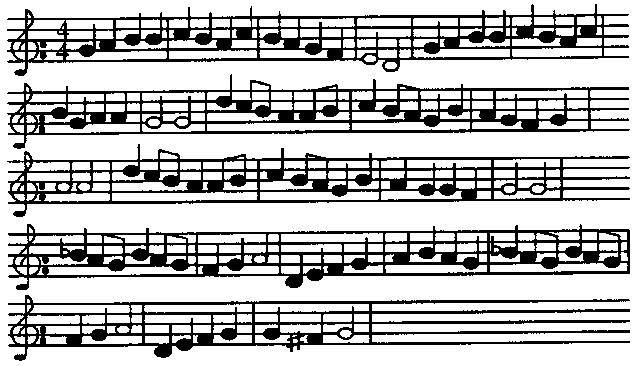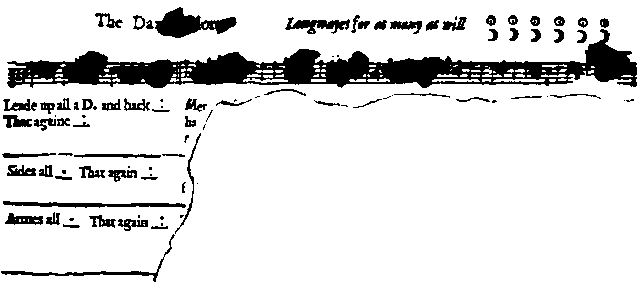
[ This article appeared in volume 2 of the Letter of Dance. ]
by Dani of the Seven Wells
This dance is an earlier and simpler variation of The Black Nag. Experts agree that the added figures in the latter dance were introduced primarily in order to protect the choreographer from charges of plagiarism. It has been noted that the chordal structure of the music has a striking resemblance to that of the French "Horses Bransle". Thus, not only does this dance stand as a pre-1650 precursor to a favorite English dance, but it also constitutes strong evidence of an ongoing dialectic between English and French dance.
This article is organized in two parts. First, Playford's orginal instructions are reproduced. In the second section, a reconstruction is given using modern notation. Extensive footnotes are provided to expand upon those instructions.

[Editor's note: due to the poor condition of the only surviving copy of the dance, the melody line (and, indeed, even the title) are a bit hard to read. To prevent eyestrain and annoyance, we provide a transcription below, and a version of the music written out in modern notation. ]
The Dark Horse -- Longways for as many as will Lead up a D. forwards and back . That againe : ----------------------------------------------- Sides all . That againe : ----------------------------------------------- Armes all . That againe : -----------------------------------------------
| 1-4 | Forward and back a double |
| 5-8 | repeat 1-4 |
| 9-12 | Siding, passing left shoulders |
| 13-16 | Siding, passing right shoulders |
| 17-20 | Arm right |
| 21-24 | Arm left |
Dance repeats

Figure 8: The Dark Horse in modern notation
[This is the second part of Fred Blonder's letter. The first commented on Dargason, on p.8, above -- Ed]
...Regarding "The Dark Horse": While perusing some of my grandmother's belongings, I came across a curious piece of paper torn so that it almost exactly matches the shape of the missing right-hand side of the manuscript illustrated on page 14 of LoD #9 [and above - Ed]. Thinking that this could be the missing piece, I lined the two halves up and came up with this reconstruction:
The Dark Horse -- Take Two
| Lead up a double, forwards & | Add egg yolks and milk, beat throroughly. |
| back, that again. | |
| Sides all, that again. | Add flour, mix thoroughly, roll out to 1/4" thick. |
| Armes all, that again. | Bake until golden brown. |
Since this dance appears to involve the preparation of food, I expect that it was done near the end of a ball, since the dancers would be hungriest then.
1. This dance was originally intended for inclusion in the first edition of Playford's English Dancing Master, which appeared in 1650/1. The only surviving copy is torn vertically, but there is no reason to believe that anything of importance was printed on the missing right side of the page.
2. Personal communication, October 1990.
3. The music for this dance and others may be found on the tape "Pre-1650 Playford." This dance may also be done to the music of "Horses Bransle", though it works better with the proper music, of course.
4. Couples should face the music, the man to the lady's left.
5. Beginning on the right foot.
Webbed by Gregory Blount of Isenfir (Greg Lindahl) (lindahl@pbm.com)